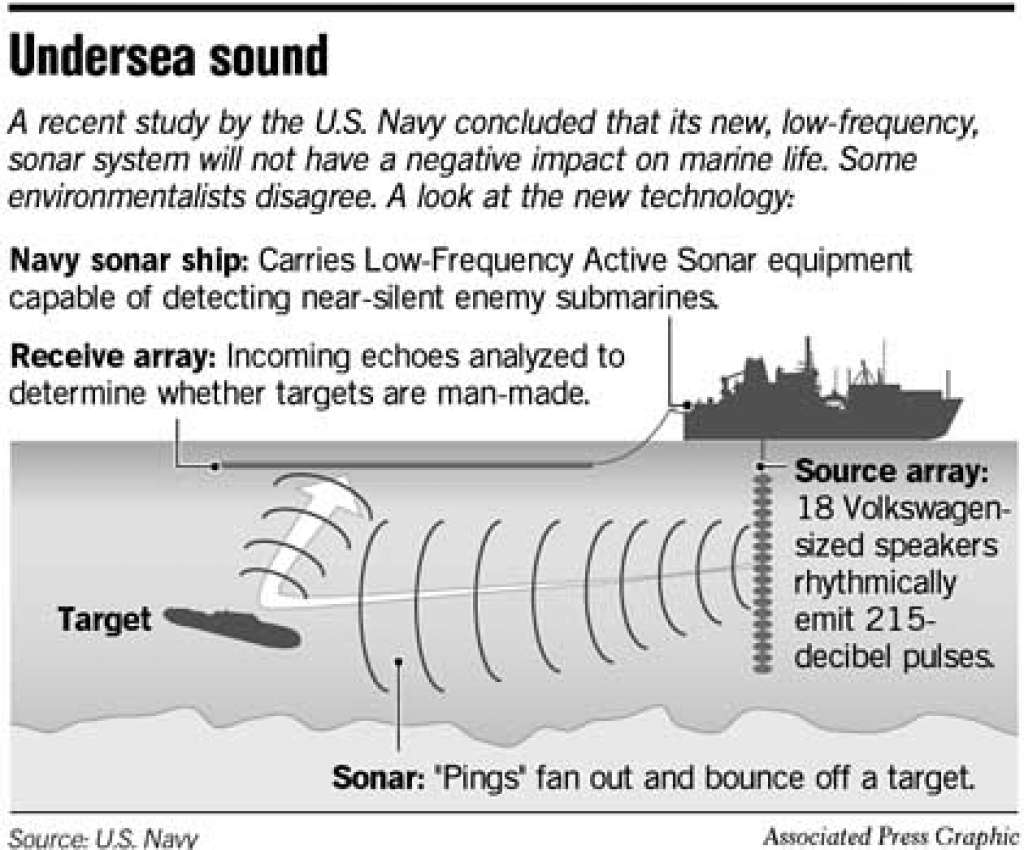U.S. Navy Plans for Loud Sonar Raises Fears for WhalesBrad Knickerbocker
Imagine a giant boombox dangled underwater, thumping out a kind of oceanic rap music louder than a jackhammer and able to be heard hundreds of miles away. That's a rough description of what the U.S. Navy would like to do to maintain global superiority in the world of submarine stealth. Even in the post-cold-war era, say Navy officials, the threat from potentially hostile subs of advanced design - able to run more silently and deeper than ever before, carrying more lethal weaponry - is growing. To counter this threat, they say, the Navy needs a new active sonar system that can locate underwater adversaries. But according to many ocean scientists, the Navy's plans are a threat to whales, dolphins, and other marine wildlife whose own advanced sonar-based means of communication and navigation is crucial to their survival. The controversy highlights two important trends: the Navy's growing frustration over environmental and other regulations that officials say are hampering their efforts to protect national security. And the growing problem of underwater noise pollution - caused by everything from warships to cruise liners to undersea mineral exploration—that may account for the troubling decline in some marine mammal species. In several cases, groups of whales and dolphins have run ashore and died in the vicinity of naval maneuvers involving sonar. The Navy says it's coincidence. But others are convinced that the animals—some of which are endangered species - experienced physiological damage that disrupted their ability to communicate and navigate safely. The National Marine Fisheries Service (responsible for protecting endangered species at sea) is considering the Navy's request to deploy the new sonar system, and the agency is expected to issue its ruling soon. Meanwhile, environmentalists and opponents in Congress and in some coastal states (including California and Maine) are fighting the request. The Navy's Surveillance Towed Array Sensor System (SURTASS) uses underwater microphones to listen for submarines. These "hydrophones" play a passive role in sub detection. The new and controversial addition to SURTASS involves the ability to broadcast low-frequency sounds that could help the Navy hear subs over longer ranges by "pinging" them with 18 Volkswagen-sized speakers, then listening for the echo.
According to the Navy, this Low Frequency Active (LFA) sonar enhancement to SURTASS would result in only the "remote possibility" of harm to marine mammals, sea turtles, and fish. "The numbers of animals potentially [harmed] would be so small as to have a negligible impact on the affected species' stocks and upon the availability of the species for subsistence needs," states a Navy fact sheet on the issue. Not so, says Marsh Green, president of the Ocean Mammal Institute in Reading, Pennsylvania. "There is a significant body of research showing that whales avoid underwater sounds starting at 110 to 120 decibels," says Dr. Green, an animal behavior specialist. (One hundred forty decibels is considered harmful to humans. The decibel scale is logarithmic, which means that a noise seems twice as loud for every increase of ten decibels.) "The sonar sound field around the transmitting ship will be 180 decibels up to one kilometer (0.6 miles) away and 150 to 160 decibels up to 160 kilometers (100 miles) away," adds Green. "This means that many marine animals will be exposed to LFA sonar levels capable of causing stranding and, possibly, lung hemorrhaging over large areas of the ocean." The incident unequivocally demonstrated the lethality of high-powered sonarsSixteen whales beached themselves in the Bahamas last summer, shortly after the Navy conducted active sonar exercises in the vicinity. Volunteers pushed most of the whales back into the ocean, but seven died - apparently victims of sound pressure that caused cranial hemorrhaging. "That incident unequivocally demonstrated the lethality of high-powered sonars," says Kenneth Balcomb, a marine biologist who witnessed the episode. Even the rescued whales have not been seen since, leading researchers to believe that they, too, perished. "The whales that we observed swimming toward shore and stranding were only temporary survivors of an acoustic holocaust that can be likened to fishing with dynamite,"says Dr. Balcomb, executive director of the Center for Whale Research in Friday Harbor, Washington. Whales also beached themselves following earlier naval sonar exercises in Greece, California, and the Canary Islands. The debate comes at a time when the Navy's submarine force is fighting for its future as Pentagon analysts advising the Bush administration question the need for expensive underwater assets developed since World War II. Part of that fight for submariners is acquiring the ability to do their job more effectively and at longer range—which they insist the LFA sonar can provide. Not only are diesel-electric (nonnuclear) submarines increasing around the world (21 countries now have them), they are becoming quieter and thus harder to detect using conventional means. Vice Admiral Malcolm Fages, who until his recent promotion headed the Pentagon's program on submarine warfare, says "The program is very, very important to us." But whether they consider themselves environmental activists or simply enjoy whale watching, many Americans have a strong desire to see marine mammals protected. This is reflected in growing congressional concern. "A substantial body of convincing science exists pointing to the potential dangers of this system for whales and other marine animals," says U. S. Rep. John Baldacci (Democrat) of Maine. "The evidence is disturbing, and given the range of science on this issue, the only prudent course of action would be for NMFS to deny these permits until additional studies and tests can be conducted and assessed." Copyright © 2001 The Christian Science Monitor Back to MENUWhales in Danger Information Service |
